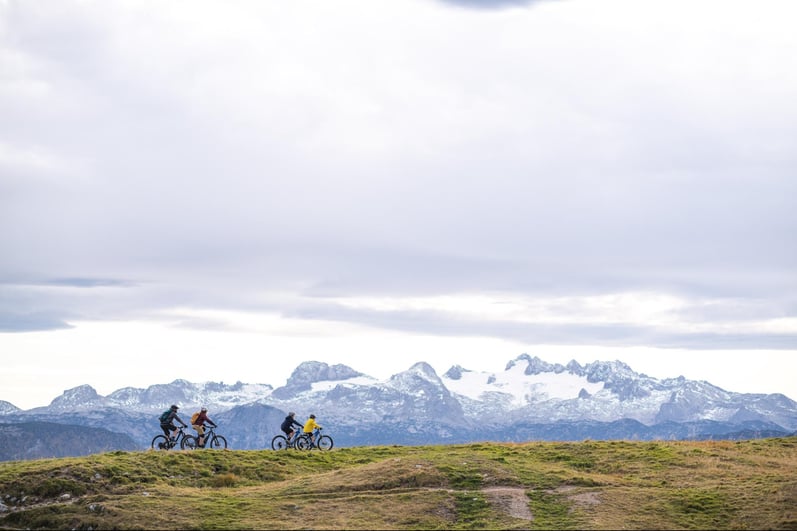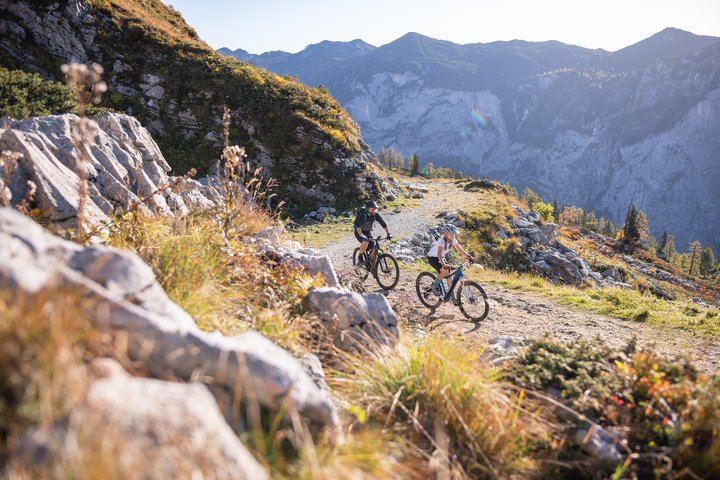Into the great green yonder! Mountain biking gets your children exercising in the fresh air and is especially fun in the woods, in fields and in the mountains. But is this outdoor activity compatible with flora, fauna and other nature lovers?
We looked into this question and we'll tip our hand in advance. The answer is, yes, mountain biking is a sport that is close to nature and environmentally friendly, under two conditions. There has to be a well-established network of routes, and we have to follow a few simple rules.
Consideration for plants and animals
- Grazing animals are generally considered tame. Still, a certain amount of caution is advisable if you encounter mountain cattle while biking; don't get too close to the animals, don't feed them, don't make any sudden movements and under no circumstances should you pet calves. When animals approach, stay calm and slowly leave the pasture, if necessary, by giving the animals a wide berth at a safe distance.
- Wild animals are nocturnal and search for food at dusk. Be considerate of these rest periods and the territory of forest animals by finishing up your bike tours before sundown, if possible. When riding at dusk and at night you should adjust your speed so as not to frighten wild animals unnecessarily.
- Respect pasture fences and, if there is a gate, use it to enter and exit the pasture. Always remember to close the gate!
- Illegally cutting across fields or taking shortcuts disturb animals in their habitat and cause soil erosion. Kids looking for adventure should let off steam on downhill trails specially made for that purpose.
- To protect the forest floor, avoid sudden changes of direction and abrupt braking manoeuvres, especially on trails and climbs, and also in muddy and wet conditions.
- Mountain flora is diverse, but unfortunately some species are endangered. The edelweiss, for instance, is subject to the strictest environmental protection, which is why you should not thoughtlessly pick flowers or mushrooms.
- In general, you should try not make any unnecessary noise, and you should take out everything you bring in or dispose of it in an environmentally friendly way in the nearest dustbin.
Respectful coexistence
- To avoid frightening hikers when approaching from behind, you should draw attention to yourself in well ahead of time – by ringing your bell, for instance. If necessary, stop and always let hikers pass – both uphill and downhill. A friendly greeting usually keeps the mood light.
- It is advisable not to take breaks in places that are difficult to see or in curves.
- Forest roads offer enough space for friendly coexistence among different leisure sports enthusiasts. In general, groups – whether cyclists or hikers – should not take up the entire width of the path.
- Well established and heavily used hiking trails should be avoided whenever possible.
- You are a guest in the forest – stay on the designated and approved routes so as not to come into conflict with landowners, hunters or foresters. Different countries and states have different regulations governing use and driving on forest roads. It is best to get information about the local situation in advance.
- Forest roads are primarily used to transport timber out of the forest. That means that you should expect to see motor vehicles from time to time.

Adapted driving style
- The right riding and braking technique is important for safety and environmental protection.
- The best approach is a forward-looking driving style, which means that you are always on the lookout and ready to stop in time to avoid unexpected obstacles, hikers or vehicles. When riding on gravel, on forest roads and in wet conditions you have to allow for a longer braking distance.
- As we mentioned already, controlled braking prevents damage to the soil. Especially in wet conditions, you should brake with a light touch, otherwise your wheels can lock up, skid and damage the forest floor.
- Entering curves at high speed endangers other people and yourself. So before you ride into a curve, you should apply the brakes.
- Before your first mountain biking excursion you should make sure that your children have their bikes well under control – this works best with a few playful exercises.
Explain these fair play rules to your kids and make them aware of the different motives and needs of other users of natural resources, such as hikers, hunters, foresters and alpine farmers. With the right behaviour you can ensure that everyone is able to enjoy nature to the fullest or go about their work undisturbed.
Apart from considerate behaviour, you can also give something back because designated MTB tracks and trails have to be cared for and maintained. Many trail centres and clubs are delighted with offers to help out, for example:
- Trailwish on the Zugerberg in Switzerland: https://zugerbergtrail.ch/trailwisch-der-zweite/
- Trailcenter Albtal in Germany: https://www.trailcenteralbtal.de/
- Massa Vecchia in Italy: https://www.massavecchia.it/de/events-de/trailbau-wochen-2019/
- Wiener Wald Trails in Austria: https://www.wienerwaldtrails.at/the-state-of-the-trails-2-0/
Sources
https://www.alpenverein.at/portal_wAssets/docs/bergsport/sicheramberg/cardfolder/Alpenverein_SicherAmBerg-Cardfolder-Mountainbike.pdf
https://www.alpenverein.at/portal_wAssets/docs/natur-umwelt/aktuell/4_bergsport-umwelt/Wegefreiheit/Diskussionspapier_MTB.pdf
https://www.allmountain.ch/naturschutz-was-ich-als-mountainbiker-tun-kann/



